
Notes From Olympia: March 3, Week 8 of the 2023 Legislative Session
This edition includes a focus on Floor activity, the role of Rules Committees, trivia and more!
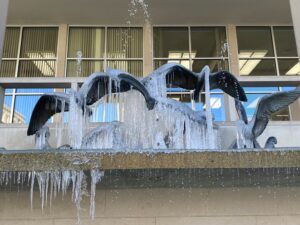 Frigid winter weather hits the Du Pen Fountain in front of the Joel Pritchard Building.
Frigid winter weather hits the Du Pen Fountain in front of the Joel Pritchard Building.
(Photo Credit: Erica Hallock)
Trivia
For this week’s trivia, let’s play a game. What jumps out to you from this “class picture” from 1889?
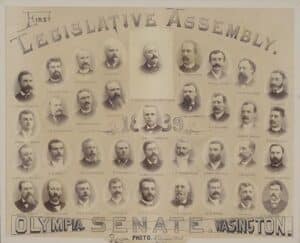
State Tax Collections Update
The Washington State Economic and Revenue Forecast Council is meeting at 8 a.m. on March 3 to receive an economic review. Meeting materials provide a preview of the topics of discussion. With regard to revenue, tax collections are $89 million (or 1.1%) over November 2022 projections. Consumer spending was also stronger than expected, but questions remain about whether the nation is headed toward a recession in 2023.
The next full revenue report will be released on March 20.
Floor Activity
This week’s legislative activity was squarely focused in the Legislative Building with both the Senate and House deliberating bills that passed their respective policy and fiscal committees. This action is expected to continue over the weekend as the 5 p.m., March 8 “House of Origin” deadline looms.
During Floor activity, lobbyists congregate on the third floor of the Legislative Building in clusters reminiscent of a high school quad, waiting to track down lawmakers with a nudge or question about a bill. This week also serves as a painful reminder that hours standing on marble floors wear on one’s feet and back.
The Transitional Kindergarten bill passed the Appropriations Committee with amendments. The House Appropriations Committee passed House Bill 1550 on Feb. 24. A discussion on the bill can be seen on TVW at the 2:01 mark and the vote at the 3:24 mark. As a reminder, this bill would convert the Transitional Kindergarten (TK) program to a new Transition to Kindergarten (TTK) program with new standards and would remove basic education as the funding source. The committee made several amendments to the bill including:
- Conversion of TK programs run by public school districts during the 2023- 24 school year to the new TTK program if they meet new program standards with intent to continue funding
- Requires the Office of Superintendent of Public Instruction (OSPI) to develop a process for public school districts to apply to operate or expand a TTK program by Dec. 31, 2023
- Requires TTK instructors with an early elementary education endorsement to have 24 college credits or 60 clock hours in early childhood education within five years of assignment to the program
- Changes the TTK funding formula from the estimated statewide allocation per kindergarten student (currently about $12,773/child) to the Early Childhood Education and Assistance Program (ECEAP) average rate (currently about $12,621/child) adjusted for the school district’s regionalization factor
- Provides TTK eligibility to children who lack access to an early learning program or have been referred by a licensed early learning provider
- Adds a null and void clause to the bill meaning that if the Legislature does not allocate funds for this purpose, the legislation is not enacted
An amendment to add charter schools and state-tribal education compact schools failed. Currently, charter schools have 288 students in existing TK programs and state-tribal compact schools do not currently operate TK programs. The bill is now in the House Rules Committee.
Legislative Lowdown
Committees in both the Senate and the House of Representatives play key roles during this period of intense Floor activity. Before a bill that has passed out of a Policy and/or Fiscal Committee can be moved to the Floor, it must first pass through the Rules Committee, whose members determine which bills will move forward and in what order. In short, the Rules Committees have the power to decide if and when legislation will go to the Floor for debate and a vote. The Rules Committees provide legislative leadership with an additional tool to manage and oversee the bills heading to the full chambers.
In both the Senate and House, the Rules Committee are made up of members from both parties. The House Rules Committee is led (or Chaired) by the House Speaker, currently Rep. Laurie Jinkins, and has 24 members, including 15 Democrats and 9 Republicans, this session. The Senate Rules Committee is chaired by the Lieutenant Governor, currently Lt. Gov Denny Heck, and has 16 legislators comprised of 10 Democrats and 6 Republicans. Rules Committee meetings can be scheduled or held “on the fly.” For example, the Senate Rules Committee issued a notification earlier this week of a Wednesday meeting “following adjournment or during the dinner break.”
The vernacular used to describe the process of a bill moving from the Rules Committee to the Floor is called a “Rules pull.” There are a variety of ways bills can be “pulled.” Individual Rules Committee members can be provided a specific number of “pulls” where they request bills move to the Floor for debate and consideration. Here’s an example of the results of some of these individual member pulls during the March 1 Senate Rules Committee meeting tracking which members requested specific bills move to the Floor. Note Senate Majority Leader Andy Billig used one of his “pulls” to move SB 5225 relating to Working Connections Child Care eligibility to the Floor.
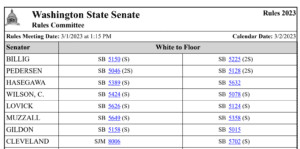
Another way is a “package pull” (seen below, again from the March 1 Senate Rules Committee meeting). Package pulls are when a package of bills is voted on by the Rules committee all at once. This can happen before a cutoff, at the end of the legislative session, or when a body is going to address a topic with several bills.
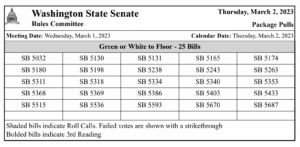
The final way is called a “consent package bill.” This represents a consent list containing bills that have faced little to no opposition thus far in the process. Here is an example of a consent pull:
There are any number of reasons why a committee member may choose a bill to move out of the Rules Committee and onto the Floor including choosing a bill important to them or their constituents, or per a request by a legislator or stakeholder group, among other reasons. The Rules Committee hearings can now be seen on TVW throughout the legislative session. This coverage began during the pandemic and has continued, making these hearings much more accessible.
I already geeked out enough, so won’t describe the meaning behind the “green” sheet or “white” sheet, but check out the description provided on the legislative website if you want to learn more.
Bill Tracker: Key Early Learning Bills
As the legislative session progresses, our resource page will update with a weekly bill tracker. Please note that legislation changes quickly, so the version on our website may not represent a bill’s latest version as it is published the Thursday of each week.
Trivia Answer
 Senate Class of 1889
Senate Class of 1889
(Photo Credit: Washington State Legislature)
This photo caught my eye for several reasons, but the most obvious observation for me was the misspelling of our state’s name – “Wasington” instead of Washington. Other observations include the overuse of periods (…..) and that the picture is from 1889 – the year Washington officially became a state!
“Class pictures” stretching back more than a century fill the halls of the Senate and House offices in the Legislative Building. When I am waiting for legislative appointments, I often find myself viewing these class pictures. They are most definitely a window into the hair and glasses styles of different eras. There are some examples of very high beehive hair-dos on the few female lawmakers during the late 1960s – early 1970s, including the picture below featuring 6 of 82 women lawmakers elected to legislative positions between 1912 and 1982.
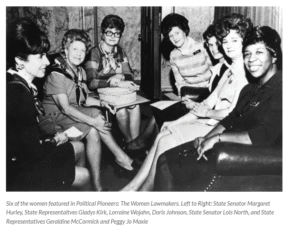 (Photo Credit: Humanities Washington)
(Photo Credit: Humanities Washington)
Moving from older photos to more recent classes, you can see modest steps toward better representation amongst our elected officials. The picture in our trivia question clearly shows that 124 years ago, the Senate was fully comprised of white men.
When women began to enter the Legislature, it was not uncommon to see them listed in the class pictures under their husband’s names. For example, in 1923, Mabel Ingersoll Miller was elected to represent the 48th legislative district from Snohomish County, but she was listed as Mrs. Harry John Miller in official legislative materials. Representative Miller’s legislative committee assignments were restricted to the “women’s committees” of Public Morals and Playgrounds and Parks.
Today, our Legislature is more representative of our state’s population with robust and growing Members of Color Caucuses in both the Senate and the House as well as representation in the highest levels of legislative leadership. And, our elected leaders are identified by their own names and are not limited in their committee assignments.
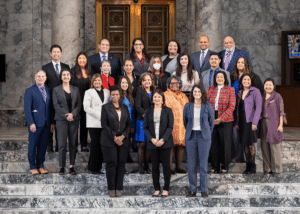 Washington State House of Representatives Members of Color Caucus, 2023-2024 – Not pictured: Rep. Cindy Ryu
Washington State House of Representatives Members of Color Caucus, 2023-2024 – Not pictured: Rep. Cindy Ryu
(Photo Credit: Washington State House of Representatives Members of Color Caucus)
 Washington State Senate Members of Color Caucus, 2023-2024
Washington State Senate Members of Color Caucus, 2023-2024
(Photo Credit: Washington State Senate Members of Color Caucus)
Have a trivia idea? We’d love to hear suggestions or questions you might have. Feel free to send me an email at ehallock@startearly.org with your trivia suggestions.
About the Author

Erica Hallock
Director, Policy & Advocacy, Start Early Washington
Erica Hallock serves as the Director of Policy and Advocacy for Start Early Washington. She has worked in early childhood, health and human services policy in both California and Washington state.
More Like This
Contact Us
Connect with our team to learn more about our work or discuss how we can support policy and advocacy work for your organization.
Washington State Hub
Learn more about our work in Washington state and access relevant resources and publications.

